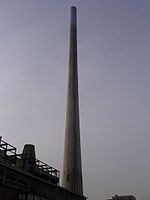Gelsenkirchen (UK: , US: , German: [ˌɡɛlzn̩ˈkɪʁçn̩] (listen); Westphalian: Gelsenkiärken) is the 25th most populous city of Germany and the 11th most populous in the state of North Rhine-Westphalia with 262,528 (2016) inhabitants. On the Emscher River (a tributary of the Rhine), it lies at the centre of the Ruhr, the largest urban area of Germany, of which it is the fifth largest city after Dortmund, Essen, Duisburg and Bochum. The Ruhr is located in the Rhine-Ruhr Metropolitan Region, one of Europe's largest urban areas. Gelsenkirchen is the fifth largest city of Westphalia after Dortmund, Bochum, Bielefeld and Münster, and it is one of the southernmost cities in the Low German dialect area. The city is home to the football club Schalke 04, which is named after Gelsenkirchen-Schalke. The club's current stadium Veltins-Arena, however, is located in Gelsenkirchen-Erle.
Gelsenkirchen was first documented in 1150, but it remained a tiny village until the 19th century, when the Industrial Revolution led to the growth of the entire area. In 1840, when the mining of coal began, 6,000 inhabitants lived in Gelsenkirchen; in 1900 the population had increased to 138,000. In the early 20th century, Gelsenkirchen was the most important coal mining town in Europe. It was called the "city of a thousand fires" for the flames of mine gases flaring at night. In 1928, Gelsenkirchen was merged with the adjoining cities of Buer and Gelsenkirchen-Horst. The city bore the name Gelsenkirchen-Buer, until it was renamed Gelsenkirchen in 1930. The city remained a center of coal mining and oil refining during the Nazi Era, so it was often a target of Allied bombing raids during World War II. There are no longer colliers in Gelsenkirchen with the city searching for a new image, having been hit for decades with one of the highest unemployment rates in Germany. Today Germany's largest solar power plant is located in the city. In Gelsenkirchen-Scholven there is a coal-fired power station with the tallest chimneys in Germany (302 m).








